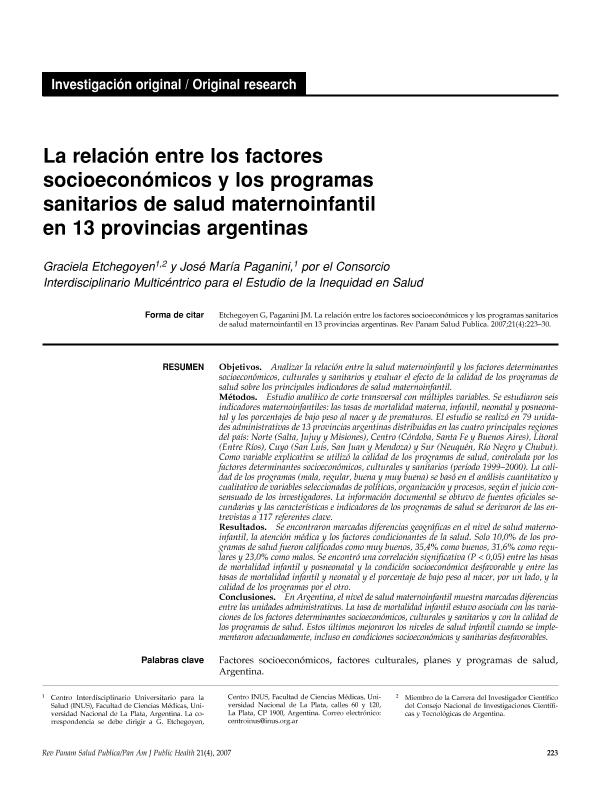Artículo
Objetivos. Analizar la relación entre la salud maternoinfantil y los factores determinantes socioeconómicos, culturales y sanitarios y evaluar el efecto de la calidad de los programas de salud sobre los principales indicadores de salud maternoinfantil. Métodos. Estudio analítico de corte transversal con múltiples variables. Se estudiaron seis indicadores maternoinfantiles: las tasas de mortalidad materna, infantil, neonatal y posneonatal y los porcentajes de bajo peso al nacer y de prematuros. El estudio se realizó en 79 unidades administrativas de 13 provincias argentinas distribuidas en las cuatro principales regiones del país: Norte (Salta, Jujuy y Misiones), Centro (Córdoba, Santa Fe y Buenos Aires), Litoral (Entre Ríos), Cuyo (San Luis, San Juan y Mendoza) y Sur (Neuquén, Río Negro y Chubut). Como variable explicativa se utilizó la calidad de los programas de salud, controlada por los factores determinantes socioeconómicos, culturales y sanitarios (período 1999–2000). La calidad de los programas (mala, regular, buena y muy buena) se basó en el análisis cuantitativo y cualitativo de variables seleccionadas de políticas, organización y procesos, según el juicio consensuado de los investigadores. La información documental se obtuvo de fuentes oficiales secundarias y las características e indicadores de los programas de salud se derivaron de las entrevistas a 117 referentes clave. Resultados. Se encontraron marcadas diferencias geográficas en el nivel de salud maternoinfantil, la atención médica y los factores condicionantes de la salud. Solo 10,0% de los programas de salud fueron calificados como muy buenos, 35,4% como buenos, 31,6% como regulares y 23,0% como malos. Se encontró una correlación significativa (P < 0,05) entre las tasas de mortalidad infantil y posneonatal y la condición socioeconómica desfavorable y entre las tasas de mortalidad infantil y neonatal y el porcentaje de bajo peso al nacer, por un lado, y la calidad de los programas por el otro. Conclusiones. En Argentina, el nivel de salud maternoinfantil muestra marcadas diferencias entre las unidades administrativas. La tasa de mortalidad infantil estuvo asociada con las variaciones de los factores determinantes socioeconómicos, culturales y sanitarios y con la calidad de los programas de salud. Estos últimos mejoraron los niveles de salud infantil cuando se implementaron adecuadamente, incluso en condiciones socioeconómicas y sanitarias desfavorables. Objectives. To analyze the relationship between maternal and infant health and socioeconomic, cultural, and sanitation factors in Argentina; to evaluate how health program quality affects the primary health indicators for mothers and infants. Methods. This is a cross-sectional study with multiple variables. The authors studied six indicators for maternal and infant health: rates for maternal, infant, neonatal, and postneonatal mortality; the percentage of newborns with low birthweight; and the percentage of premature newborns. The study was conducted in 79 administrative units in 13 provinces that represent different geographic regions of Argentina. They included (1) the provinces of Salta and Jujuy in northwest Argentina; (2) the provinces of Cordoba, Santa Fe, and Buenos Aires in central Argentina; (3) the provinces of Entre Rios and Misiones in the Mesopotamia or northeast region; (4) the provinces of San Luis, San Juan, and Mendoza in the Cuyo or northwest, Andean region; and (5) the provinces of Neuquén, Rio Negro, and Chubut in the south. The explanatory variable in the study was the quality of health programs, controlled by socioeconomic, cultural, and sanitation factors in 1999 and 2000. The definition of program quality ("poor," "average," "good," and "very good") was based on quantitative and qualitative analysis of selected variables such as policies, organization, and procedures as determined by the investigators. Documentation was obtained from secondary official sources. The investigators interviewed 117 health system managers (including supervisors of provincial and local health programs, administrators of maternal and child health programs, and hospital directors), who provided information on characteristics and indicators of the health programs. Results. There were marked geographic differences in the levels of maternal and infant health, medical care, and socioeconomic, cultural, and sanitation factors. Only 10.0% of health programs were classified as "very good," 35.4% as "good," 31.6% as "average," and 23.0% as "poor." There was a significant correlation (P < 0.05) between rates of infant and postneonatal mortality and adverse socioeconomic circumstances. There was also a significant correlation between the percentage of low birthweight infants and the quality of health programs. Conclusions. There are clear disparities in the level of maternal and infant health care in different administrative units in Argentina. The infant mortality rate was associated with variations in socioeconomic, cultural, and sanitation factors and with the quality of health programs. Health programs improved infant health when appropriately implemented, even in adverse socioeconomic and sanitation conditions.
La relación entre los factores socioeconómicos y los programas sanitarios de salud maternoinfantil en 13 provincias argentinas
Título:
The relationship between socioeconomic factors and maternal and infant health programs in 13 Argentine provinces
Fecha de publicación:
04/2007
Editorial:
Organización Panamericana de la Salud
Revista:
Revista Panamericana de Salud Pública
ISSN:
1020-4989
e-ISSN:
1680-5348
Idioma:
Español
Tipo de recurso:
Artículo publicado
Clasificación temática:
Resumen
Archivos asociados
Licencia
Identificadores
Colecciones
Articulos(CCT - LA PLATA)
Articulos de CTRO.CIENTIFICO TECNOL.CONICET - LA PLATA
Articulos de CTRO.CIENTIFICO TECNOL.CONICET - LA PLATA
Citación
Etchegoyen, Graciela Susana; Paganini, Jose Maria; La relación entre los factores socioeconómicos y los programas sanitarios de salud maternoinfantil en 13 provincias argentinas; Organización Panamericana de la Salud; Revista Panamericana de Salud Pública; 21; 4; 4-2007; 223-230
Compartir
Altmétricas




